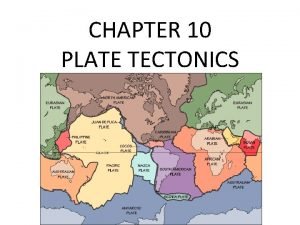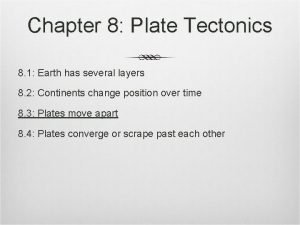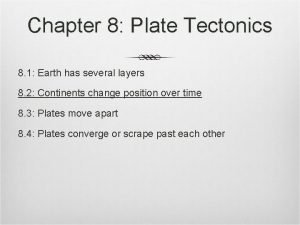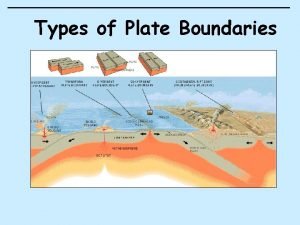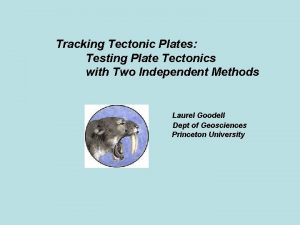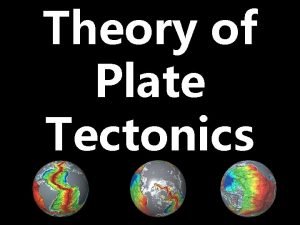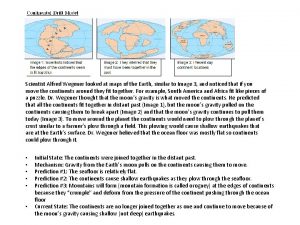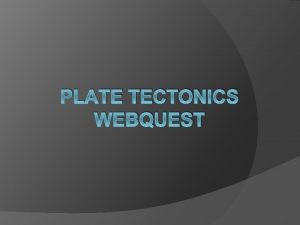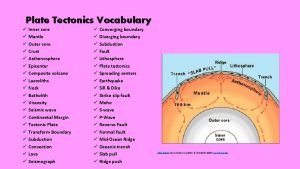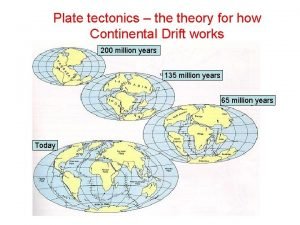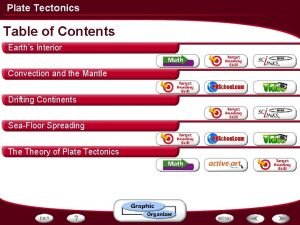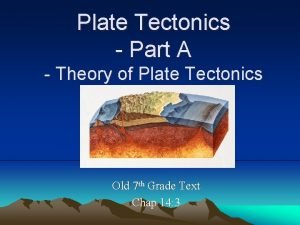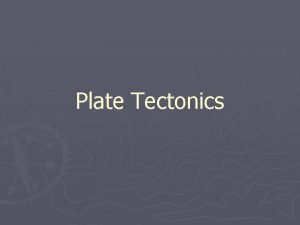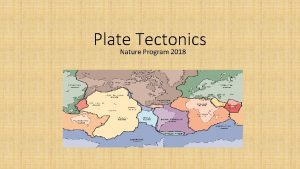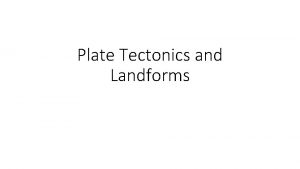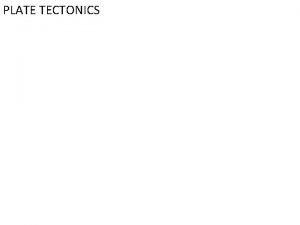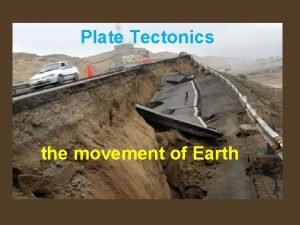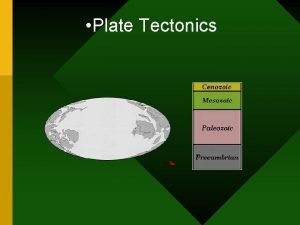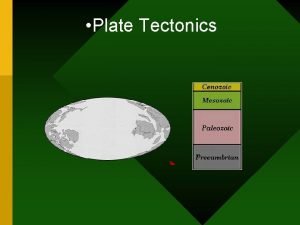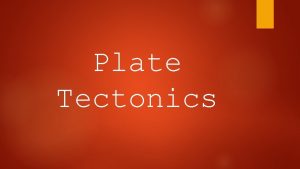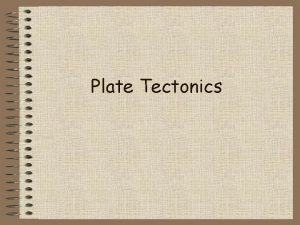Chapter 8 Plate Tectonics 8 1 Earth has














- Slides: 14

Chapter 8: Plate Tectonics 8. 1: Earth has several layers 8. 2: Continents change position over time 8. 3: Plates move apart 8. 4: Plates converge or scrape past each other

8. 2: Continents change position over time Before, you learned: Earth’s main layers are the core, mantle, and crust The lithosphere and asthenosphere are the topmost layers of Earth The lithosphere is made up of tectonic plates Now, you will learn: How the continental drift hypothesis was developed About evidence for plate movement from the sea floor How scientists devloped theory of plate tectonics

Core, Mantle, Crust Litho – “stone” or “rock” Asthenes – “weak” Lithosphere: crust and very top of mantle – solid, most rigid layer Asthenosphere: hotter, softer rock in the upper mantle (just below the lithosphere) – can flow like hot tar Less dense materials rise Denser materials sink

Continents join together and split apart As far back as the 1500’s, map makers noticed the western coast of Africa and the eastern coast of South America seemed to fit together 1912, German scientist Alfred Wegener proposed the hypothesis: continental drift

Evidence for Continental Drift Fossils: Fossils of an ancient (270 million years ago) reptile: Mesosaurus were found in South America AND western Africa, but no where else in the world Explanation: the continents were once joined Climate: Greenland today is mostly covered in ice, yet tropical plant fossils are found there South Africa is warm, but rocks were deeply scratched by ice sheets Geology: Kinds of rocks that make up the continents: those found in Brazil match those in western Africa Limestone layers in the Appalachian Mountains (NA) exactly like Scotland’s Highlands

Pangaea and Continental Drift Huge supercontinent over 200 million years ago Pangaea, “all lands” Centered over where Africa lies today But how?

The theory of plate tectonics explains how plates and their continents move Mid-1900 s – scientists proved tectonic plates move Evidence from the sea floor: Huge underwater mountain ranges: mid-ocean ridges circling earth like baseball seams

The theory of plate tectonics explains how plates and their continents move Evidence from the Sea Floor: Sea-Floor Spreading: the ridges form along cracks in the crust, melted rock rises through these cracks, cools, and forms new oceanic crust

The theory of plate tectonics explains how plates and their continents move Evidence from the sea floor: Age of the sea floor: youngest rocks cloest to the ridge, oldest rocks farther away Oldest ocean floor is young – 160 to 180 my old; continental crust much older: 4 billion yrs Ocean Trenches Sea floor spreads, then dense oceanic crust sinks into the asthenosphere (upper mantle) into huge trenches (like deep canyons) Old crust destroyed as new crust forms – Earth remains the same size

Causes of Plate Movement Tectonic plates rest on the asthenosphere – layer of soft, hot rock Moves by convection: heat transfer by the movement of a material Hot soft rock rises, cools, and sinks, then is heated and rises again: convection current – slow few cm/yr Slab pull: gravity pulls the edge of a cool, dense plate into the asthenosphere – the entire plate is dragged along Ridge push: material from a mid-ocean ridge slides downhill from the ridge


Putting the Theory Together Theory of plate tectonics: the Earth’s lithosphere is made up of huge plates that move over the surface of the Earth One plate could not shift without affecting the others nearby Plates can move apart, push together, or scrape past each other Most major earthquakes, volcanoes, and mountain ranges appear where tectonic plates meet


List of animations! http: //www. wwnorton. com/college/geo/egeo/animatio ns/ch 2. htm
 Chapter 10 plate tectonics
Chapter 10 plate tectonics Chapter 8 plate tectonics
Chapter 8 plate tectonics Chapter 8 plate tectonics
Chapter 8 plate tectonics Plate tectonics vs continental drift
Plate tectonics vs continental drift What are four types of plate boundaries
What are four types of plate boundaries Plate motion calculator
Plate motion calculator The plate tectonics theory states that:
The plate tectonics theory states that: The geological theory that states that pieces
The geological theory that states that pieces Compare continental drift and plate tectonics
Compare continental drift and plate tectonics Plate tectonics webquest answers
Plate tectonics webquest answers Plate tectonics vocabulary
Plate tectonics vocabulary Convergent plate boundary
Convergent plate boundary Seafloor spreading material at trenches
Seafloor spreading material at trenches Plate tectonics definition
Plate tectonics definition Driving force of plate tectonics
Driving force of plate tectonics
